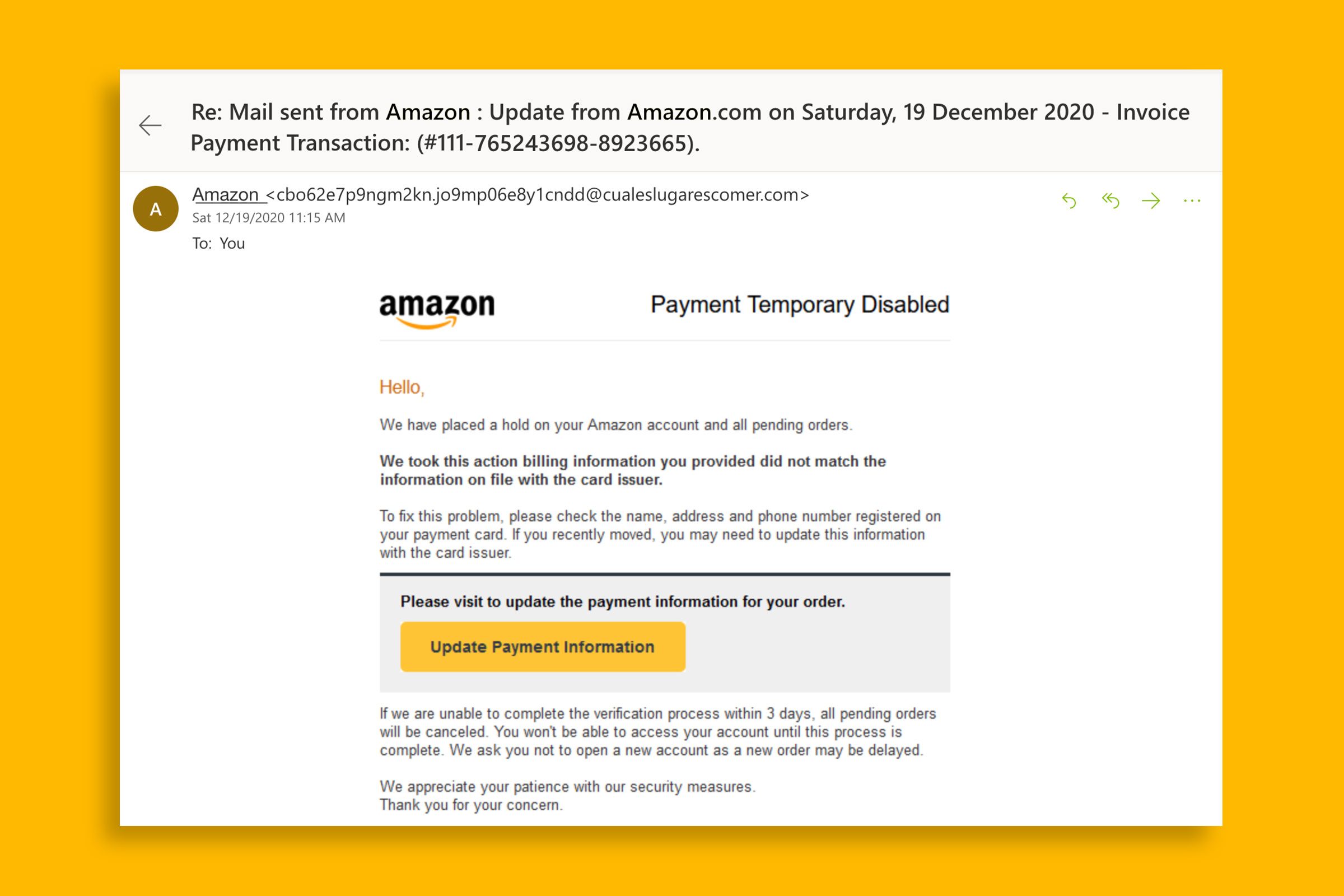Not every email from Amazon is legitimate. Keep an eye out for these telltale signs you might be dealing with a scammer.

This Is What an Amazon Email Scam Looks Like

Just when you thought you knew how to avoid online scams, fraudsters have gotten trickier—and more convincing. Many of them have started to send emails impersonating popular retailers. The most common type of this scam is the Amazon email scam— not surprising given that Amazon is the world’s largest online retailer.
In fact, Amazon scams account for one in three business impersonation scams, according to the Federal Trade Commission. Amazon reports that, since late 2024, 70% of scams that customers have reported have tried to uncover customer account information and payment details—typically via fake emails.
“An Amazon email scam can look exactly like a real Amazon email, or can be poorly crafted, and everything in between,” according to Alex Hamerstone, a director with the security-consulting firm TrustedSec. “But the core scams are usually pretty similar, as are the risks, the ways to prevent them, and the recommended response.”
To protect you from falling victim to an Amazon email scam, we asked experts to share what these scams look like, why they’re so dangerous, and what to do if you receive one.
Get Reader’s Digest’s Read Up newsletter for more scam news, humor, travel, tech and fun facts all week long.
What does an Amazon email scam look like?

Amazon email scams vary, but they often include details that imitate the brand, like the company logo. “Scammers try to leverage high-profile brands to trick consumers into becoming victims of scams,” says Brian Cute, the CEO and capacity and resilience program director for the Global Cyber Alliance. Because of the trust many of us automatically have for major companies, it can be tough to spot a scam when you receive an email that looks familiar enough.
Here are a few of the most common versions of this scam to know.
Fake Amazon order scams
According to Amazon’s latest report on trending scams, nearly half of the impersonation scams reported to the company have been messages about fake orders you never made. They often include an alert claiming there’s a problem with shipping your order or processing your payment. “The goal is to get you to think you need to update your account information, and usually give the scammer your credit card or bank information,” explains Hamerstone.
Amazon driver scams
Since 2024, scammers have also begun impersonating Amazon delivery drivers requesting urgent attention to a delivery order. “Considering how many of us receive goods delivered directly to our homes, most people are susceptible to this scam by virtue of our anxiety that we won’t receive our purchases,” says Seth Ruden, a certified fraud examiner and global advisory director for the U.S. and Canada at BioCatch, a cybersecurity company specializing in digital fraud prevention.
Like other phishing emails, this scam typically works by urging you to click a malicious link to fix the problem. “Don’t click on links in unsolicited emails or messages, especially those that ask for personal information,” says Cute.
Membership renewal scams
Unlike emails about shipping, payment or delivery issues—which could invoke a sense of urgency—membership renewal scams are easy to fall for because they seem ordinary. Scammers might claim that your payment method is invalid or your membership is expiring. Again, the goal is typically to get your credit card information or to trick you into clicking a malicious link.
For all of these scenarios, there’s a simple way to avoid falling prey to scammers: Check for legitimate messages and updates directly from Amazon, Ruden says. Official communications will always appear on the Amazon website in the Message Center or on the app.
Why are Amazon email scams dangerous?

These days, Amazon email scams target more than one form of sensitive personal information. A scammer’s goal might be to convince you to click a link or open an attachment that installs a virus or other harmful software on your computer. The scam could also be hoping to gain access to your Amazon account or financial information by tricking you into entering your log-in credentials, credit card number, or other personal data like your Social Security number, says Eva Velasquez, president and CEO of the Identity Theft Resource Center.
What can happen if you fall for an Amazon email scam?
When you share your log-in, credit card number, or other personal information with scammers, they can use your bank or Amazon account to make purchases and run up hefty charges. “These scams are all targeting your money,” says Chris Pierson, CEO of BlackCloak, a cybersecurity company. “The cybercriminals want either access to your account and the ability to purchase items or access to your credit card—both of which can cause you financial harm.” Criminals can also use your personal information to steal your identity, according to Velasquez. Your personal information could also be used in a doxxing attack if it falls into the wrong hands.
How to recognize a fake Amazon email scam

While some email services provide tools to filter out the worst and most obvious phishing attempts, scammers still manage to break through. “I would still not trust these filters to block all high-risk content,” says Ruden. “In this age of deepfakes and AI-driven content delivery, it’s critical to be guarded and suspicious of all messages you receive.”
Think an email from Amazon looks phony? The best way to avoid Amazon phishing scams is to look out for these red flags:
- Urgency, like demands to take immediate action
- Suspicious language, grammatical errors, or typos
- Email address with the incorrect domain name (i.e., something other than @amazon.com)
- Key phrases like “There is a problem with your account. Please click here to verify your account or change your password,” “Here is your receipt and shipping confirmation” for a product you never ordered, or “Please verify your payment method.”
- Requests to send gift cards, a.k.a. “verification cards,” share personal information like credit card numbers, or click a link
Remember: Amazon customer service will never ask you to click external links, move conversations to another platform, or ask for sensitive information via email or social media, says Cute.
Steps to take if you receive an email from Amazon
Sometimes, even when you know these red flags, it’s hard to tell if an email is real or not, especially since scammers are constantly becoming more sophisticated. Here’s what to do:
- If you’ve received an email about an Amazon order, open Amazon’s website directly through your browser, log in to your account, and look under “Your Orders” to see if any orders match the details in the email.
- If the email asks you to confirm or update your account information, visit your Message Center on Amazon.com to determine if the alert is legitimate. Any official communications will appear there.
What to do if you fall victim to one of these email scams
If you believe you are the victim of an Amazon email scam, “The first thing to do is log into your Amazon account, change the password, and turn on dual-factor authentication,” Pierson says. He also recommends going to Login & Security > Compromised Account? on Amazon’s website, where you’ll get the best Amazon account protection tips. Be sure to click on the “Sign-Out Everything” button to block the scammer from accessing your account. Contact your bank or credit card company if you gave out your financial information.
Next, report the scam to Amazon and the FTC so they can open an investigation. Notify Amazon by sending an email to [email protected]. The company says the best way for them to track it is for you to send the suspicious email as an attachment. Then mark the suspicious email as spam and delete it from your inbox.
About the experts
|
Why trust us
Reader’s Digest has published hundreds of articles on personal technology, arming readers with the knowledge to protect themselves against cybersecurity threats and internet scams as well as revealing the best tips, tricks and shortcuts for computers, cellphones, apps, texting, social media and more. For this piece, Brooke Nelson Alexander tapped her experience as longtime journalists and tech reporter. We rely on credentialed experts with personal experience and know-how as well as primary sources including tech companies, professional organizations and academic institutions. We verify all facts and data and revisit them over time to ensure they remain accurate and up to date. Read more about our team, our contributors and our editorial policies.
Sources:
- Digital Commerce 360: “Amazon ECommerce Facts & Statistics”
- Federal Trade Commission: “FTC Data Spotlight on scammers impersonating Amazon: How businesses can reduce injury to consumers”
- Amazon.com: “The latest Scam Trends from Amazon: Fake Customer Service Accounts – A Rising Social Media Scam Threat”
- Alex Hamerstone, advisory solutions director at TrustedSec
- Brian Cute, CEO and capacity and resilience program director for the Global Cyber Alliance
- Seth Ruden, certified fraud examiner and global advisory director for the U.S. and Canada at BioCatch
- Eva Velasquez, president and CEO of the Identity Theft Resource Center
- Chris Pierson, PhD, CEO of BlackCloak
- Amazon.com: “Common Gift Card Scams”
- Amazon.com: “Report a Scam”






















